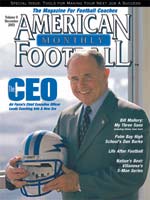AMERICAN FOOTBALL MONTHLY THE #1 RESOURCE FOR FOOTBALL COACHES
Article CategoriesAFM Magazine
|
Right Place Right Timeby: Richard Scott© More from this issue Brian Kelly will tell you that luck put him in position to be one of the top head coaches in Division II football. His record at Grand Valley State will tell you otherwise. Yes, it’s true that Kelly was coaching linebackers and coordinating the defense in Massachusetts at his alma mater, Assumption College, when an old friend called Kelly and told him he was leaving his job as Grand Valley State’s defensive coordinator to become a head coach. “It’s like anything else in the business: it truly is a fraternity, it’s the people you know,” Kelly says. “That gave me my first opportunity to come to Grand Valley.” Kelly joined the Grand Valley State football staff in 1987 as a graduate assistant and secondary coach. Two years later, he was promoted to defensive coordinato....The full article can only be seen by subscribers. Subscribe today!
|
|
|||||||
| HOME |
MAGAZINE |
SUBSCRIBE | ONLINE COLUMNISTS | COACHING VIDEOS |
Copyright 2026, AmericanFootballMonthly.com
All Rights Reserved





